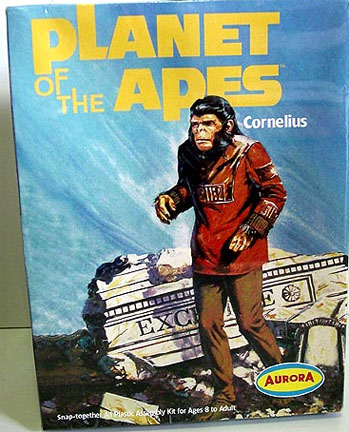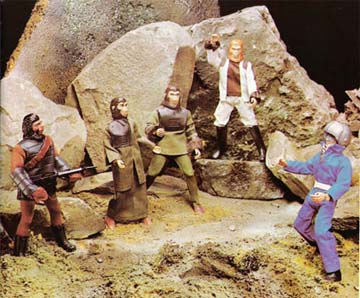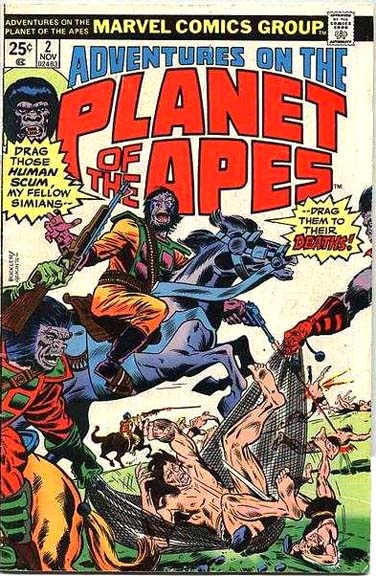I was too young to see the first POTA movie, but I was quite familiar with its iconic imagery through movie trailers, posters, and pictures in the newspaper. I was intrigued by Charlton Heston in his homo-erotic loin cloth and leather restraints, the state-of-the-art ape make-up and quasi-medieval outfits, and the ape city of stucco and wood buildings with the San-Diego-Zoo-Goes-Condo motif. Unfortunately, the first POTA movie I saw was Conquest of the Planet of the Apes, which had none of that. Instead, I was treated to Ricardo Montalban dragging Roddy McDowell on a leash through some near-future
In all there were five POTA films, the first two being the only ones worth repeated viewings, in my opinion. The first took a fairly decent stab at Pierre Boulle’s novel, although budget restraints prohibited showing the book’s more modern ape world of cars and helicopters and such. The second film, Beneath the Planet of the Apes, had a more adventurous flair, showing a race of intelligent humans who have survived in the remains of
 By 1974, I was completely sucked into the POTA whirlwind. My first pieces of POTA memorabilia were the Cornelius and Dr. Zaius model kits which my dad bought me while we were on vacation in Wildwood, NJ. Since the kits were snap-together, I built them on the way home in the back seat of our ’67 Chrysler Newport. Later, I was thrilled to learn that CBS was premiering a POTA television show that fall. Simultaneously, the Christmas catalogues were filled with Mego’s new POTA action figures and accessories, based on the original film. I immediately put in my begging requests for all the Mego figures and the
By 1974, I was completely sucked into the POTA whirlwind. My first pieces of POTA memorabilia were the Cornelius and Dr. Zaius model kits which my dad bought me while we were on vacation in Wildwood, NJ. Since the kits were snap-together, I built them on the way home in the back seat of our ’67 Chrysler Newport. Later, I was thrilled to learn that CBS was premiering a POTA television show that fall. Simultaneously, the Christmas catalogues were filled with Mego’s new POTA action figures and accessories, based on the original film. I immediately put in my begging requests for all the Mego figures and the
 While I eagerly waited through the fall of ’74 for my POTA figures, I watched the new POTA t.v. show. Wisely ignoring the later feature films, the t.v. show took the basic premise from the original movie (astronauts passing through a time/space warp and landing on a future Earth inhabited by apes), and fashioned a different storyline where two astronauts are forever running away from the apes who want to suppress these thinking humans. Roddy McDowell plays an ape called Galen (still wearing his Cornelius make-up and costume), who befriends the astronauts and helps them on their escape from ape justice. Initially, I enjoyed the show, but after it became clear that this series was simply The Fugitive in fur, I lost interest. By the time Christmas rolled around, I was no longer watching the show and was happy to play out the movie version with my action figures. Mego eventually put out new POTA figures based on the t.v. show, but it may have already been cancelled by then. Once I exhausted all my POTA story lines, I reimagined my gorilla soldier figure as a super hero whom I named Commander Kong. I thought the idea was pretty nifty to have a sentient, M-16 wielding gorilla fighting crime.
While I eagerly waited through the fall of ’74 for my POTA figures, I watched the new POTA t.v. show. Wisely ignoring the later feature films, the t.v. show took the basic premise from the original movie (astronauts passing through a time/space warp and landing on a future Earth inhabited by apes), and fashioned a different storyline where two astronauts are forever running away from the apes who want to suppress these thinking humans. Roddy McDowell plays an ape called Galen (still wearing his Cornelius make-up and costume), who befriends the astronauts and helps them on their escape from ape justice. Initially, I enjoyed the show, but after it became clear that this series was simply The Fugitive in fur, I lost interest. By the time Christmas rolled around, I was no longer watching the show and was happy to play out the movie version with my action figures. Mego eventually put out new POTA figures based on the t.v. show, but it may have already been cancelled by then. Once I exhausted all my POTA story lines, I reimagined my gorilla soldier figure as a super hero whom I named Commander Kong. I thought the idea was pretty nifty to have a sentient, M-16 wielding gorilla fighting crime.
 After that Christmas, I continued to have a fascination with POTA, as did much of the world, apparently. Marvel Comics, trying to move beyond the bullpen of super heroes they had unleashed, put out POTA comic books, both in the traditional format and in a magazine format with black-and-white artwork. A Saturday morning animated series was also made, which I enjoyed far more than the live-action show. Without the worries of creating sets and costumes, the animated series presented an ape world closer to Boulle’s vision, with gorilla soldiers driving jeeps and flying planes. Also, the show’s look was designed by Jonny Quest creator Doug Wildey, so it had a cool feel despite the limited animation.
After that Christmas, I continued to have a fascination with POTA, as did much of the world, apparently. Marvel Comics, trying to move beyond the bullpen of super heroes they had unleashed, put out POTA comic books, both in the traditional format and in a magazine format with black-and-white artwork. A Saturday morning animated series was also made, which I enjoyed far more than the live-action show. Without the worries of creating sets and costumes, the animated series presented an ape world closer to Boulle’s vision, with gorilla soldiers driving jeeps and flying planes. Also, the show’s look was designed by Jonny Quest creator Doug Wildey, so it had a cool feel despite the limited animation.
My passion for POTA petered out somewhere in 1977. Once Star Wars was released, movie studios put the sci-fi machine in high gear, and there was just so much more out there to take in. Just like so many of the childhood memories I have shared in this blog, POTA had its time and place in my heart before something else turned my head. The full bore passion may have faded a long time ago, but each of these pop culture icons has left a piece of joy in my heart which has never left me.




No comments:
Post a Comment